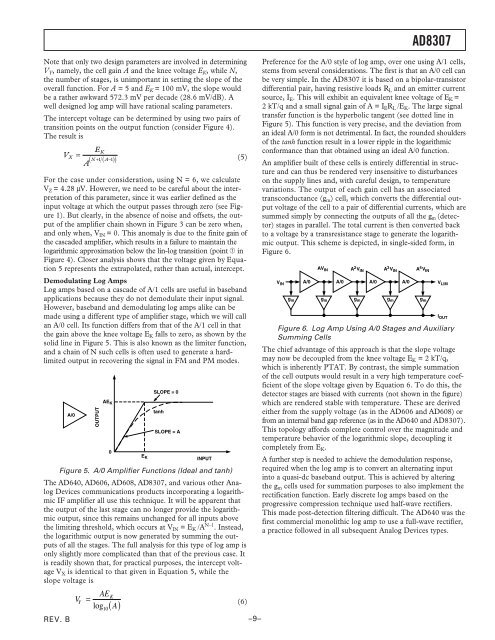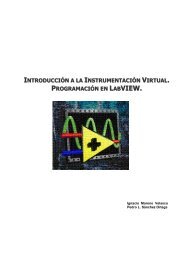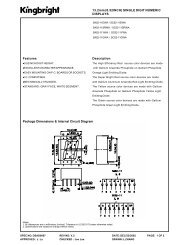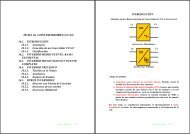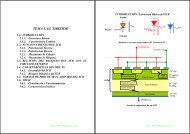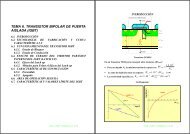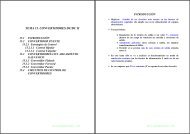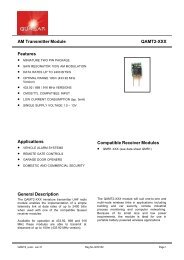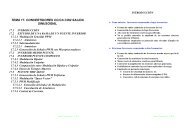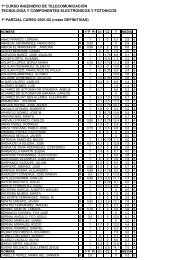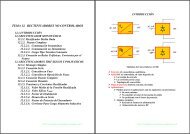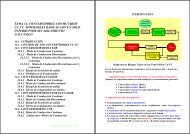AD8307 Low Cost DCâ500 MHz, 92 dB Logarithmic Amplifier Data ...
AD8307 Low Cost DCâ500 MHz, 92 dB Logarithmic Amplifier Data ...
AD8307 Low Cost DCâ500 MHz, 92 dB Logarithmic Amplifier Data ...
You also want an ePaper? Increase the reach of your titles
YUMPU automatically turns print PDFs into web optimized ePapers that Google loves.
Note that only two design parameters are involved in determining<br />
V Y , namely, the cell gain A and the knee voltage E K , while N,<br />
the number of stages, is unimportant in setting the slope of the<br />
overall function. For A = 5 and E K = 100 mV, the slope would<br />
be a rather awkward 572.3 mV per decade (28.6 mV/<strong>dB</strong>). A<br />
well designed log amp will have rational scaling parameters.<br />
The intercept voltage can be determined by using two pairs of<br />
transition points on the output function (consider Figure 4).<br />
The result is<br />
V<br />
X<br />
REV. B<br />
EK<br />
=<br />
( N+ 1 ( A−1 ))<br />
(5)<br />
A<br />
For the case under consideration, using N = 6, we calculate<br />
V Z = 4.28 µV. However, we need to be careful about the interpretation<br />
of this parameter, since it was earlier defined as the<br />
input voltage at which the output passes through zero (see Figure<br />
1). But clearly, in the absence of noise and offsets, the output<br />
of the amplifier chain shown in Figure 3 can be zero when,<br />
and only when, V IN = 0. This anomaly is due to the finite gain of<br />
the cascaded amplifier, which results in a failure to maintain the<br />
logarithmic approximation below the lin-log transition (point ➀ in<br />
Figure 4). Closer analysis shows that the voltage given by Equation<br />
5 represents the extrapolated, rather than actual, intercept.<br />
Demodulating Log Amps<br />
Log amps based on a cascade of A/1 cells are useful in baseband<br />
applications because they do not demodulate their input signal.<br />
However, baseband and demodulating log amps alike can be<br />
made using a different type of amplifier stage, which we will call<br />
an A/0 cell. Its function differs from that of the A/1 cell in that<br />
the gain above the knee voltage E K falls to zero, as shown by the<br />
solid line in Figure 5. This is also known as the limiter function,<br />
and a chain of N such cells is often used to generate a hardlimited<br />
output in recovering the signal in FM and PM modes.<br />
A/0<br />
OUTPUT<br />
AE K<br />
0<br />
E K<br />
SLOPE = 0<br />
tanh<br />
SLOPE = A<br />
INPUT<br />
Figure 5. A/0 <strong>Amplifier</strong> Functions (Ideal and tanh)<br />
The AD640, AD606, AD608, <strong>AD8307</strong>, and various other Analog<br />
Devices communications products incorporating a logarithmic<br />
IF amplifier all use this technique. It will be apparent that<br />
the output of the last stage can no longer provide the logarithmic<br />
output, since this remains unchanged for all inputs above<br />
the limiting threshold, which occurs at V IN = E K /A N–1 . Instead,<br />
the logarithmic output is now generated by summing the outputs<br />
of all the stages. The full analysis for this type of log amp is<br />
only slightly more complicated than that of the previous case. It<br />
is readily shown that, for practical purposes, the intercept voltage<br />
V X is identical to that given in Equation 5, while the<br />
slope voltage is<br />
V<br />
Y<br />
AEK<br />
=<br />
(6)<br />
log 10 A<br />
( )<br />
–9–<br />
<strong>AD8307</strong><br />
Preference for the A/0 style of log amp, over one using A/1 cells,<br />
stems from several considerations. The first is that an A/0 cell can<br />
be very simple. In the <strong>AD8307</strong> it is based on a bipolar-transistor<br />
differential pair, having resistive loads R L and an emitter current<br />
source, I E . This will exhibit an equivalent knee voltage of E K =<br />
2kT/q and a small signal gain of A = I E R L /E K . The large signal<br />
transfer function is the hyperbolic tangent (see dotted line in<br />
Figure 5). This function is very precise, and the deviation from<br />
an ideal A/0 form is not detrimental. In fact, the rounded shoulders<br />
of the tanh function result in a lower ripple in the logarithmic<br />
conformance than that obtained using an ideal A/0 function.<br />
An amplifier built of these cells is entirely differential in structure<br />
and can thus be rendered very insensitive to disturbances<br />
on the supply lines and, with careful design, to temperature<br />
variations. The output of each gain cell has an associated<br />
transconductance (g m ) cell, which converts the differential output<br />
voltage of the cell to a pair of differential currents, which are<br />
summed simply by connecting the outputs of all the g m (detector)<br />
stages in parallel. The total current is then converted back<br />
to a voltage by a transresistance stage to generate the logarithmic<br />
output. This scheme is depicted, in single-sided form, in<br />
Figure 6.<br />
A 3 V IN<br />
A 4 V IN<br />
V IN A/0<br />
A/0<br />
A/0<br />
A/0<br />
V LIM<br />
g m<br />
AV IN<br />
g m<br />
A 2 V IN<br />
g m<br />
Figure 6. Log Amp Using A/0 Stages and Auxiliary<br />
Summing Cells<br />
The chief advantage of this approach is that the slope voltage<br />
may now be decoupled from the knee voltage E K = 2 kT/q,<br />
which is inherently PTAT. By contrast, the simple summation<br />
of the cell outputs would result in a very high temperature coefficient<br />
of the slope voltage given by Equation 6. To do this, the<br />
detector stages are biased with currents (not shown in the figure)<br />
which are rendered stable with temperature. These are derived<br />
either from the supply voltage (as in the AD606 and AD608) or<br />
from an internal band gap reference (as in the AD640 and <strong>AD8307</strong>).<br />
This topology affords complete control over the magnitude and<br />
temperature behavior of the logarithmic slope, decoupling it<br />
completely from E K .<br />
A further step is needed to achieve the demodulation response,<br />
required when the log amp is to convert an alternating input<br />
into a quasi-dc baseband output. This is achieved by altering<br />
the g m cells used for summation purposes to also implement the<br />
rectification function. Early discrete log amps based on the<br />
progressive compression technique used half-wave rectifiers.<br />
This made post-detection filtering difficult. The AD640 was the<br />
first commercial monolithic log amp to use a full-wave rectifier,<br />
a practice followed in all subsequent Analog Devices types.<br />
g m<br />
g m<br />
I OUT


